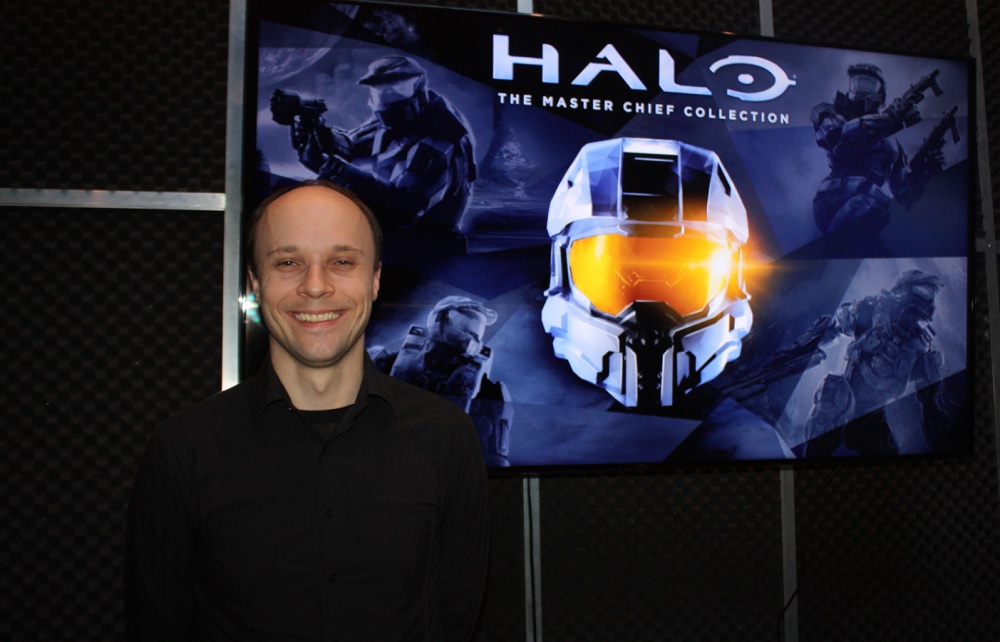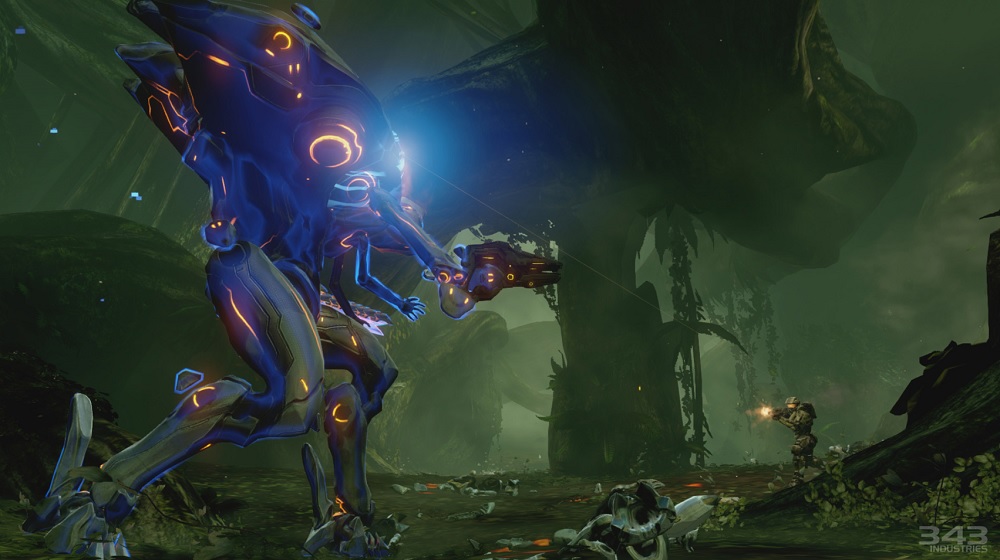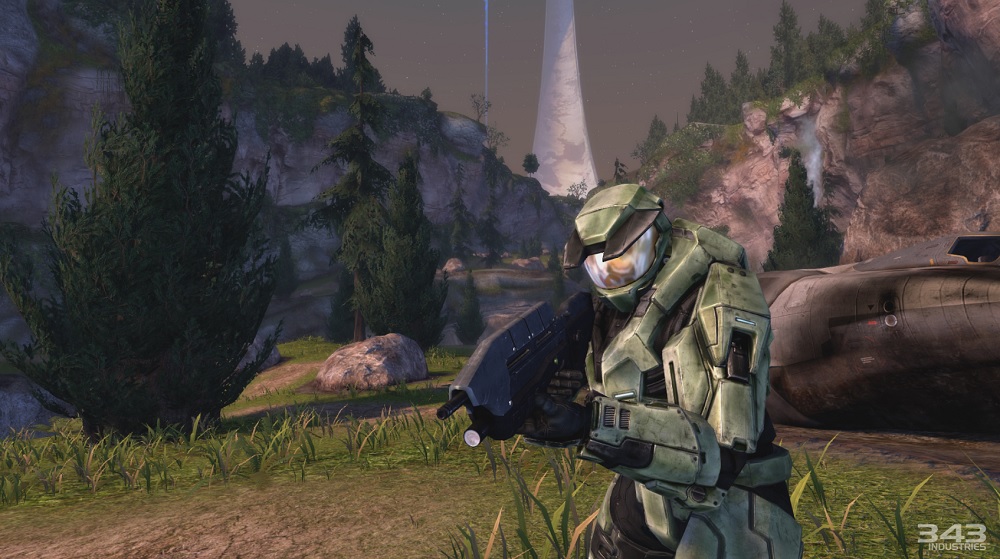Halo games have sold more than 60 million copies since the series debut 13 years ago. And Microsoft knows that every one of the fans who have played Halo has different tastes. They all have their favorite moments, and highlighting those moments is one of the more difficult parts of creating Halo: The Master Chief Collection, the Xbox One suite of games that comes out on Tuesday and includes four Halo games that feature theI ho main character Master Chief: Halo Combat Evolved (2001), Halo 2 (2004), Halo 3 (2007), and Halo 4 (2013). Not a bad deal for $60, right?
Microsoft’s 343 Industries has taken these games, added high-definition art where needed, and put them all in a single suite playable on the Xbox One game console. You can go through the series and play any mission, out of sequence, as you wish. You can create “playlists” of missions, like putting together all of the tank missions from all four games. Along the way, Microsoft had to provide both the classic look of the original games, and a modern HD look as well. It also added all-new achievements and a kind of metagame that rewards the completionists who want to get a reward for finishing everything in the set. Gamers may not want to hear about it, but this was a lot of work.
To talk about this, we caught up with Max Szlagor, senior designer at 343 Industries, the Microsoft studio that makes the Halo games. He talked about the huge task of making fans happy, either by leaving things the same or modernizing them. Here’s an edited transcript of our interview.
GamesBeat: Did you join 343 as a game designer for the Master Chief Collection, or any other particular project?
AI Weekly
The must-read newsletter for AI and Big Data industry written by Khari Johnson, Kyle Wiggers, and Seth Colaner.
Included with VentureBeat Insider and VentureBeat VIP memberships.
Szlagor: No, I started working on some Halo 4 DLC, the Champions bundle.
GamesBeat: What are you discovering about the way people like to play the collection so far?
Szlagor: Everybody has different preferences as far as which games they like. Some people like the older feel of Halo and Halo 2. Some like the more modern feel of the remastered Halo 2 Anniversary, or different game types. Same with the campaign experience. Everyone has their favorite things they gravitate towards. We want them to enjoy it the way they want to play, so we have a lot of options there.
GamesBeat: Have you added up the number of hours of single-player gameplay?
Szlagor: I don’t know if you can quantify it, to be honest. We have the four campaigns, but also 450 achievements we’ll have there, as well as some of the new scoring features and speedrunning features. It’s been built with replay in mind. It’s hard to count up the hours people in there.
GamesBeat: The cross-campaign play is an interesting feature. What are some of the possibilities there?
Szlagor: For each game, there are some themes. Within Halo 2, for example, you can play as either Master Chief or the Arbiter. Those levels are interspersed as you play through it. But we have some playlists that are specifically the Master Chief levels or the Arbiter levels. Some are just the tank levels. Some put maps that are bigger epic battles back to back, or tight corridor battles, or jungle levels, or levels that take place where you can see the Halo rings, or that focus on a particular character. There’s a good variety of different combinations.
GamesBeat: Is anything proving especially popular?
Szlagor: For the most part, it’s just like with the other pieces. Everyone’s gravitating toward their particular favorite games. There’s been good feedback around the cross-game playlists.
GamesBeat: It was a little jarring going from Halo 2 multiplayer to Halo 3, where it was so much slower. Can you talk about that change, and then speeding it up again in Halo 4?
Szlagor: Each game has its own characteristics. Everyone has a different preference for where they like the feel of the game. What we’ve done to smooth that out in this particular collection is make sure that we have the universal control scheme. You can apply any one setting or combination of settings for controls across all the games. Or, if you really prefer particular controls for that game — some people, for example, they use the universal scheme for three games, but then they use a default for that one other game.
That said, for custom games, you’re also able to set a number of game options. If you like faster movement speed on some games, that’s an option. Even when we do the matchmaking playlists, we’ll listen to feedback and see where people gravitate toward and how they want the feel of gameplay to work. For matchmaking, we can customize to the experience people want.
GamesBeat: When you split the multiplayer up in that many different ways, do you still have enough of a base audience for each flavor?
Szlagor: I think so. It’s been interesting to see, actually. We work with some pro players as we develop these games. Some of them still gravitate toward the Halo 1 feel or the Halo 2 classic feel. It’s all been thought through as far as, how do we retain that classic feel while still bringing in some of the newer, modern elements? We see a distribution of people who have a particular game preference.
GamesBeat: Did you hear any feedback on the cross achievements that are happening with the mobile game?
Szlagor: We’re always looking at ways to give fans an opportunity to carry over their experience from game to game. It’s something we’ve done in the past with Halo. People appreciate recognition that they’ve played games all across different platforms.
GamesBeat: What are some of the oddest achievements that people go for now?
Szlagor: One thing that we tried to do was to bring in — Halo has a rich history of Easter eggs in these games, things the developers put in a long time ago. Some of those are recognizable. There’s a Scarab gun that you can get in Halo 2, but you have to either hijack a Banshee in a very difficult place, or use grenade jumps to get up there. There’s a soccer ball in one level, or a hidden sword. There’s signage that calls out to some of the people that were there, or hidden faces in different parts of levels. We have achievements tied to a lot of that stuff.
Some of them are easier to find. Others are going to require a lot of hunting. We’ve tried to dig deep on that stuff so that some things people may not have known about, or that very few people were able to accomplish, we’re able to pull in recognition for that effort.
GamesBeat: When I was playing, it seemed like I was almost mis-remembering a lot of things — the quality of the graphics, how high I could jump. It’s interesting, going back to something older like this. With the passage of time, I’m curious how some of these things have aged for people.
Szlagor: The remastered campaigns for Halo 1 and 2 do make them feel a lot more modern. The Halo 2 Anniversary multiplayer is obviously remastered for those maps. We’ve gotten a ton of great feedback on Halo 3 and Halo 4. Halo 3 is 2007, so it’s a good bit older, but even that particular game, running at 60 frames per second in 1080p with some of the lighting improvements, it still looks amazing.
There are details you couldn’t see in some of the original maps. You might have seen what looked like a cluster of vines, but you couldn’t make out each individual detail. Now you can see that. Halo 3 also had some cool water effects. Things could fall in the water and float. People may not remember it, because it was unique to that game, but there are lots of things that look quite a lot better now.
GamesBeat: As far as the work you had to do, how would you describe that, the development process?
Szlagor: It’s a massive development effort. We have all of these different types of games, as you pointed out. Making them feel like one cohesive game — in particular, there’s the one master UI. Each game had different options and settings and how you access multiplayer and all these other things. Being able to funnel everything through a system that makes it feel like you can take your experience from one game and apply it to another—There’s a lot of effort in thinking through the implications for how you merge these things together, like having a single matchmaking experience.
People may not remember, but Halo 1 and 2 didn’t have medals in multiplayer. That’s something we added in as another layer, to create this unified system. Campaign scoring is a more arcade-like feature, but it lets you track how well you did in a campaign level. That applies now to not just Halo 3, which is the only game in the collection that originally had it, but all four titles. We have leaderboards for that. It’s thinking about all these different features and coming up with ways to preserve all the original gameplay and feel, while still building in systems that tie them all together.



